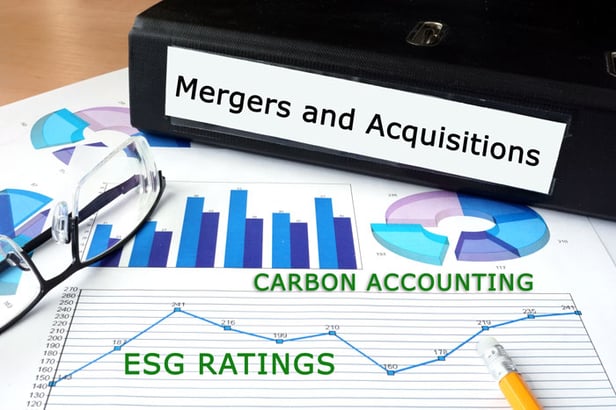Carbon Accounting was previously identified as one of the Five Key Trends to Watch in 2022, and the compliance implications were explored in this blog post Are You Ready for "Carbon Accounting" Compliance?
This update provides a focused look on how Carbon Accounting and overall Environmental, Social and Governance (ESG) practices can significantly impact companies on both sides of Merger and Acquisition (M&A) deals. See the Microsoft and Activision example below.

As the ESG and Carbon Accounting landscape continues to evolve, the investor community has become a key constituency at the forefront of proactively using companies' ESG policies and carbon accounting practices to guide their rating and investment decisions.
Many of the leading rating entities have already launched ESG focused data services that provide investors with information on thousands of public companies.
Some of the more prominent broad-based rating entities include:
- Bloomberg ESG Disclosure Scores - over 11,800 companies in more than 100 countries
- MSCI ESG Ratings - over 8,500 companies (14,000 issuers including subsidiaries)
- Morningstar Sustainalytics ESG Risk Ratings - 20,000 companies in 172 countries
- FTSE Russell’s ESG Ratings - 7,200 companies in 47 countries
- S&P Global ESG Scores - 8,000 companies worldwide
While the refinement and standardization of rating criteria is still evolving, these and other rating organizations already provide an extensive range of data, using specialized artificial intelligence (AI) methodologies for analyzing and targeting key ESG factors.
As a result, most brokerages and investment banks have launched "green" or "sustainable" funds that rely on this growing foundation of data to guide investment decisions. Over a number of years, these funds have honed their criteria for which companies to include and have simultaneously built huge followings consisting of investors who care about global sustainability issues.
So, how does all of this play into impacting M&A activity?
Within an investment environment that has become at least partially reliant on companies' "scores" for ESG, carbon footprints, and sustainability ratings, these factors now also influence the process of making M&A decisions as well as impacting the value generated by M&A deals.
Here is an excellent and timely example regarding Microsoft's acquisition of Activision as detailed in this Wall Street Journal article.
"Microsoft has developed environmental, social and governance policies over many years, including numerous environmental and workplace-diversity disclosures, and plans to compensate for all its historical greenhouse-gas emissions. Activision lags far behind, disclosing much less ESG information and having far fewer policies in place. If the deal goes through, it could take years for Microsoft to bring Activision into line with its practices."
The WSJ article further notes that "sustainability-focused funds hold more than $53 billion of Microsoft shares, making it the No. 1 stock holding for such funds". If even a small percentage of sustainability-focused funds decide that the Activision acquisition requires a reweighting or divestiture of Microsoft, it could have a major negative impact on the overall value of the deal.
This is where having a well-structured set of Carbon Accounting and ESG processes can come in very handy for M&A optimization, especially if the policies and processes can be readily adapted to incorporate and improve the sustainability processes of the newly acquired company.
In virtually all M&A situations, the companies are looking for complementary opportunities to drive higher value from the merger. Often these complementary opportunities are focused around markets, operational capabilities, assets, etc.
But, in some cases, ESG optimization can actually offer other attractive opportunities. For instance, if the company being acquired is currently undervalued because of sub-par ESG factors, an acquiring company with excellent and adaptable ESG processes could quickly drive additional value by upgrading the acquired company's processes to improve its ESG ratings.
On the flip side, an acquiring company might have sub-par ESG but could seek to achieve a quick upgrade through acquiring a well-rated company, especially if the acquired company's ESG program included valuable assets such as carbon-offsets.
Established and Extensible ESG Tools are Key to M&A Success
The issues described above are a key part of the reasons that Bramasol has standardized on helping our clients improve their ESG programs by using SAP's suite of tools including Product Footprint Management (PFM), a cloud-native application built on SAP Business Technology Platform that can be activated in SAP Analytics Cloud (SAC).
PFM enables companies to calculate carbon footprints for their products across the entire value chain and to use SAC for analyzing and optimizing specific factors, such as evaluating specific vendors' carbon footprints.
The flexibility of SAC with PFM also enables companies to model new scenarios such as proactively identifying the carbon impact at the beginning of the product lifecycle instead of reactively after a product has been produced.
For M&A deal evaluation and negotiations, this ability to model carbon accounting in PFM can also be particularly useful for proactively identifying ESG issues and modeling improvement plans to maximize value from the merged entities.
The bottom line for companies that are active in M&A, whether acquiring or being acquired, is to recognize that ESG and Carbon Accounting have now become an important factor that should be evaluated upfront and managed throughout the process to avoid downsides and to optimize overall value.

